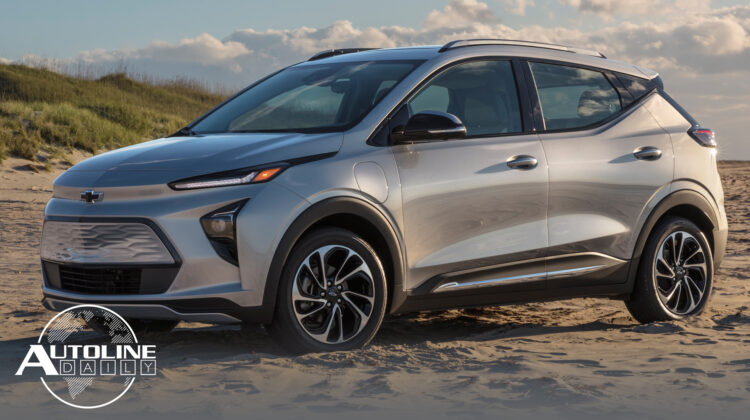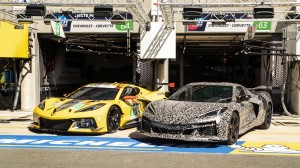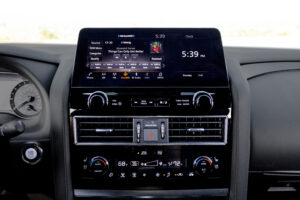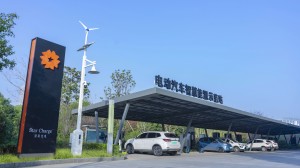
Listen to “AD #3145 – China Sets Regs. to Protect Personal Info; Chevy Recalling All Bolts; Porsche Getting Rimac Tech” on Spreaker.
Follow us on social media:
Runtime: 9:49
0:07 China Sets Regulations to Protect Personal Info
0:49 Chevy Recalling All Bolts
1:24 New Bolt Recall to Cost GM $1 Billion
2:35 Corvette Z06 Teaser Hints at New Engine
4:02 Porsche Getting Rimac Technology
4:54 Mazda Still Serious About Rotary Engines
5:25 Updated QX80 Adds Big Center Screen
6:50 China’s Charging Outlets Top 2 Million
7:29 Ford Helps Charging Company Locate Faulty Charger
Visit our sponsors to thank them for their support of Autoline Daily: BorgWarner, Bridgestone, Intrepid Control Systems, Schaeffler and Wacker.
This is Autoline Daily, the show dedicated to enthusiasts of the global automotive industry.
CHINA SETS REGULATIONS TO PROTECT PERSONAL INFO
China is setting strict regulations regarding personal information that is generated in cars. The regulations affect any data on car owners, drivers, passengers, pedestrians, and any information that can be used to identify individuals or their personal behavior. It includes data collected at EV charging stations, as well as any data from mapping, data about vehicle types and traffic flow, as well as video data that includes faces, voices and license plates. The regulations apply to the entire life cycle of a vehicle and they go into effect on October 1.
CHEVY RECALLING ALL BOLTS
Last month, GM recalled Chevy Bolts built from 2017 to 2019 over potential battery fires. Now GM is expanding the recall to include all Bolt EVs from 2019 to 2022, including the new Bolt EUV. The automaker found defects in the batteries that can lead to fires, and until it can get replacement packs its recommending owners not charge vehicles over 90% state of charge, don’t let the vehicle get below 70 miles of range and to park the vehicles outside over night.
BOLT RECALL TO COST GM $1 BILLION
The recall will cost GM $1 billion but it’s going to pass most of the bill on to LG Chem, which built the batteries. That sent the Korean battery maker’s shares down 11%. Earlier in the year, Hyundai also had to recall EVs over potential battery fires that were equipped with LG batteries.
CORVETTE Z06 TEASER HINTS AT NEW ENGINE
Since its introduction in 1954 GM has produced more than 100 million small-block V8s and one thing in that entire time has never changed; their cam-in-block overhead valve design. But with the teasing of the new Corvette Z06, which debuts on October 26th, it sure sounds like something new is in the works. The exhaust note is like nothing we’ve heard from a small-block before. There’s been a lot of speculation that it’s a flat-plane crank V8 that shares roots with 5.5L V8 Chevy races in the C8R. WardsAuto predicts the engine will be topped with overhead camshafts and 4 valves per cylinder that help push power output to 600 horsepower and 450 lb-ft of torque. The engine could be coded LT6. Wards takes speculation a step further that the ZR1 ‘Vette will get a twin-turbo version of the engine that makes 850 horsepower and 800 lb-ft of torque. While that car is not expected to be out until 2025, there could be even more versions of the Corvette than ever before. We’ve seen a number of spy photos of a camo ‘Vette testing alongside an Acura NSX. There’s rumors this could be a hybrid version of the Corvette, called the e-Ray.
RIMAC TECH HEADED TO ‘HIGH-VOLUME’ PORSCHES
When the Volkswagen Group sold off a controlling stake in Bugatti to Croatian automaker Rimac that’s what made all the headlines. Reported less is the fact that Porsche holds a 45% stake in the new Bugatti-Rimac company as well as two supervisory board positions. On top of that Porsche owns 24% of Rimac. So, you could say the two are pretty well tied up together. And that partnership is about to run even deeper. In an interview with Bloomberg, Rimac’s CEO said “We are already developing stuff that will be soon in high-volume Porsches. Not special projects, but the mainstream.” The terms of that were not revealed but Rimac provides electric components like batteries to competitors Koenigsegg and Pininfarina.
MAZDA STILL SERIOUS ABOUT ROTARY ENGINES
It looks like Mazda is still serious about reviving the rotary engine. According to the Hatena Blog in Japan, Mazda applied for eight new trademarks and four of them hint at the company’s xEV technology which uses a rotary engine in a hybrid powertrain as a mild hybrid, full hybrid or range extender. It even trademarked this logo for the models. Mazda is also rumored to be working on a hydrogen powered rotary.
QX80 REFRESH ADDS A BIG CENTER SCREEN
The new Infiniti QX80 made its debut. As you can see the exterior styling remains the same but the interior gets a new look. Most notably, the new 12.3-inch touchscreen, which includes Apple CarPlay and Android Auto, now floats on the dash. Leather seats for all three rows, heated front seats and second row captain’s chairs are all standard. It comes standard in rear-wheel drive and it’s also available in four-wheel drive. The QX80 is still powered by the same 400 horsepower 5.6L V8 engine that’s mated to a seven-speed automatic transmission.
CHINA’S CHARGING OUTLETS TOP 2 MILLION
Over the last year, China added 32,000 EV charging outlets every month. It has over 2 million charging outlets, which are called charging piles in China. 950,000 of those charging piles are public, with the rest being private. And about 40% of the public ones are fast DC chargers. There are also 763 battery swapping stations, but nearly half of them are in two cities: Beijing and Guangdong. And all this EV infrastructure is really going to help sales of electric vehicles.
FORD HELPS CHARGING COMPANY FIND FAULTY CHARGER
Meanwhile, in the U.S., there are a lot of teething problems with the EV infrastructure. People often find that the public charger they want to use doesn’t work. Darren Palmer, the head of all battery electric vehicles at Ford, tells how his engineers had to help one of the charging companies pinpoint a charger that wasn’t working. Darren was talking last week to a group of journalists at the Woodward Dream Cruise in Detroit.
“The story I mentioned is that while monitoring the network we found a software problem on one make of charger in one network. And we asked the company, ‘Please could you fix this for us?’ And they told us it’s a software update but it has to be done manually. And we said, “Great, can we get that done in the next 4 days?’ And they said, ‘I’m afraid not, it’s going to take 3 months.’ And so we thought about it together and said, ‘We cannot send a customer there if it doesn’t work because then you’re stranded.’ So we decided, ‘I’m sorry if they’re not fixed in the next 4 days we’ll remove them from the network.’ So they actually said, ‘The problem is we’ve got thousands of sites and we actually don’t know which ones are that make of charger. It wasn’t recorded at the time, so we can’t tell you which ones to remove.’ So our team, Ryan’s team (Ryan O’Gorman, Energy Services Manager, Ford)–there is a picture of each on Plug Share, online–so they used AI on pictures that were available and they identified which one was the bad make and we removed it from the network in 4 days.”
You know we have a long way to go when a car company has to tell a charging company where it has a faulty charger.
And that wraps up today’s report. Thanks for watching, we’ll see you tomorrow.
Thanks to our partner for embedding Autoline Daily on its website: WardsAuto.com
Seamus and Sean McElroy cover the latest news in the automotive industry for Autoline Daily.









